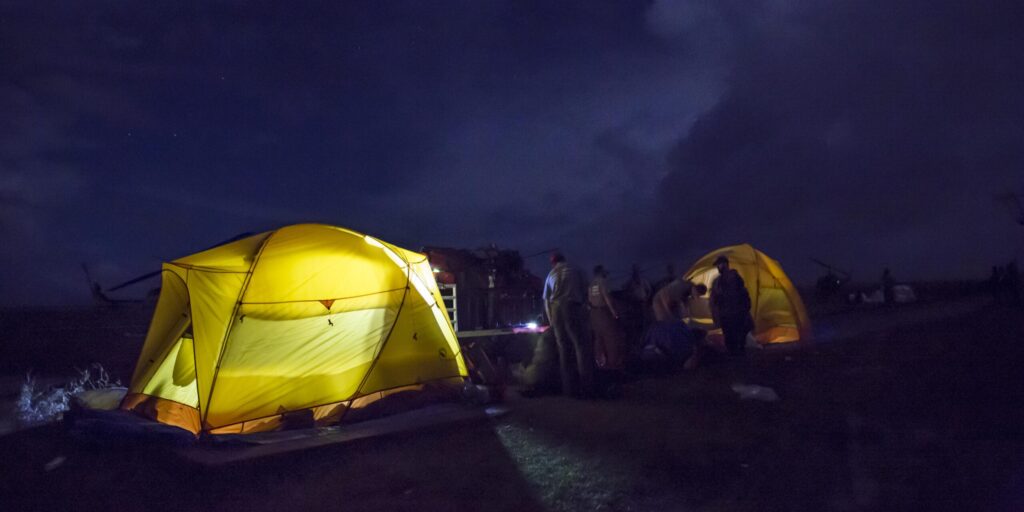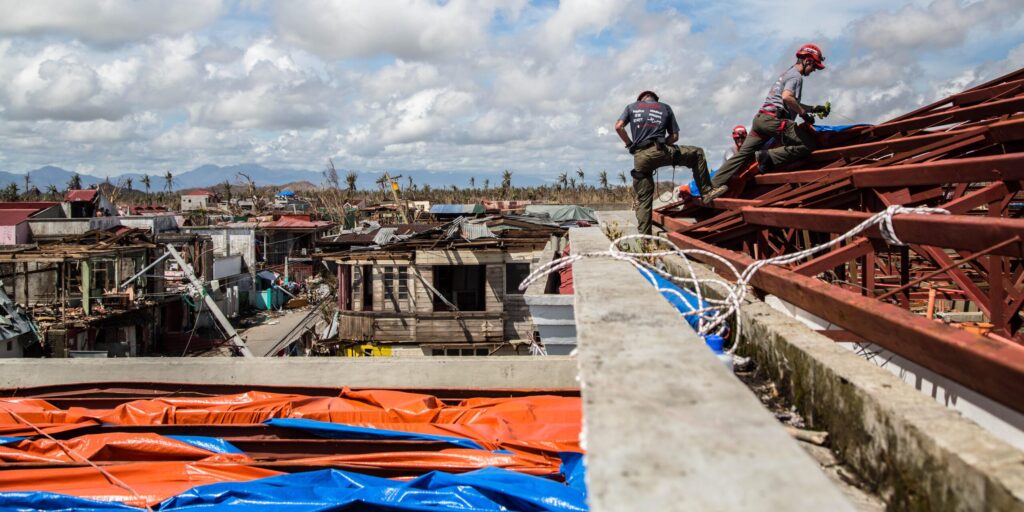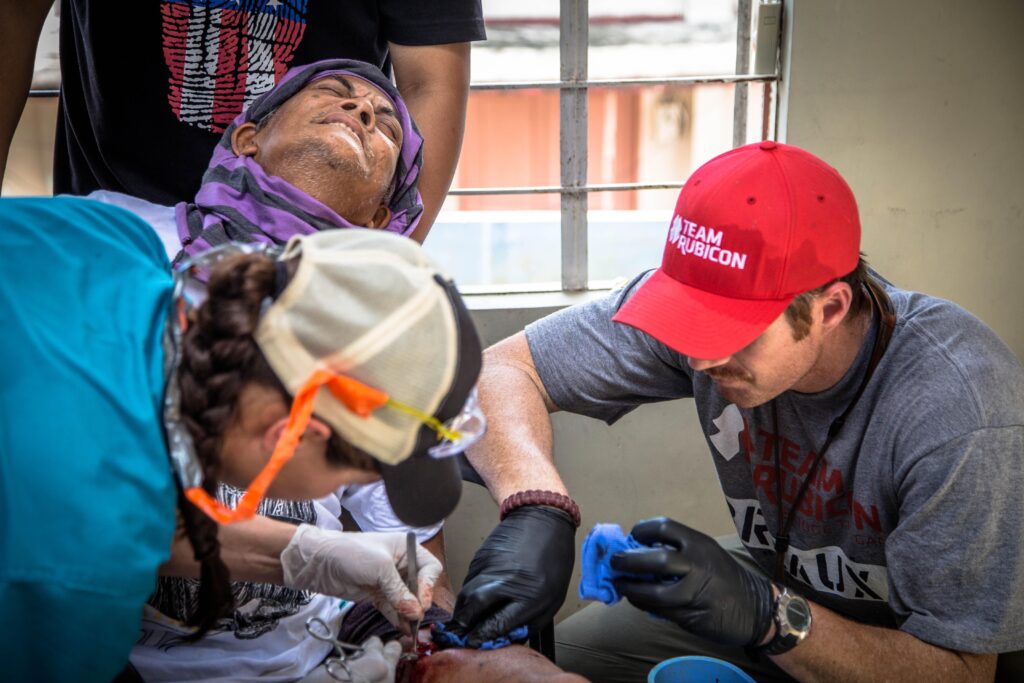Typhoon Haiyan crashed into the Philippines in November of 2013 with wind speeds close to 200 miles per hour. At the time, it was marked as the strongest typhoon ever recorded. Initially, 10,000 people were suspected dead, and the injuries were potentially in the millions.
As a Marine Corps veteran who had been serving as a fire captain and paramedic and member of the Technical Rescue Team with Durango Fire and Rescue for six years by then, I knew I had the rescue and medical skills to make some sort of difference. So, when the opportunity presented itself for my first international Team Rubicon deployment, serving on a 15-person team as the medical officer, I knew I had to make it happen. Helping was my motivator, not travel and not adventure. The operation had an “A game” vibe from the get-go: The team description was high caliber, the mission was full of unknowns, and we would be expected to figure things out with little intel or supplies. Our backpacks were going to be heavy, and sleeping in the mud was a high potential. The prospective combination of hardship, critical thinking, and a diverse team with a unique skill set was tantalizing. It made raising my hand high easy.
Upon arrival in the Philippines, we loaded our gear onto a C-130—a four-engine turboprop military transport aircraft—and quickly found ourselves putting down on the island of Leyte, in the hardest hit region: Tacloban City. To describe this disaster/destruction zone, I think of putting a community in a blender and then dumping it back out. There were very few roads; most were under 40 feet of debris. Buildings were mostly gone, roofs did not exist, and injured people and the bodies of the deceased were lying everywhere. We moved as a militant-style team through it all, staying together and learning about our surroundings as we traveled.

Before getting to work, we had to take care of ourselves and tend to the business that would allow us to operate within the country and serve the maximum number of people possible. We built our camp alongside an active airport runway surrounded by jet fuel barrels. It was not optimal. We were surrounded by a newly formed marsh. Airplanes and helicopters were landing and taking off at all hours of the day, so we lived in a cloud of jet fuel, and we were fine with it. We built out our communications with our Manila and stateside support teams, set up our logistics for resupply, and started our networking with other organizations.
Getting to work was our next top priority, which we did within hours of arrival. We started an urgent care facility at the airport, where we treated the injured for several days. We built a successful model that we handed off to another medical organization that did not have the mobile ability that we had. We mobilized our team and eventually linked up with a group of doctors based out of Mammoth, CA. This group was top-notch; they were made up of an anesthesiologist, multiple ER doctors, a trauma surgeon, an OB doctor, and several nurses. Team Rubicon linked up and helped with triage and treatments and filled in their gaps to create a well-oiled machine that saved lives. Over the next 12 days, we treated hundreds of patients. Treatments consisted of wound care and infection control, delivering babies (natural births and a C-section), and assisting Mammoth Medical Missions with amputations and other life-saving surgeries.
No hospitals existed post-disaster, so while the doctors worked, we helped build a field hospital out of a city building. Surgeries were being performed on desks and tables—not hospital beds—in a non-sterile facility under an open sky. The roof of that city building had gone missing in the typhoon.

I was among the few on the team who came with a rescue background from the fire service. We had the ability to climb several stories up on rafters and gain access to the roof while building rope belays and safety mechanisms for tarping. As we stood on what was left of the roof and started to tarp, we looked down to see the doctors’ group amputating the femur of a 7-year-old girl. The rain fell on us and past us and into the room below.
The days were long, showers were nonexistent, and our team quickly leaned on each other like family. Our team worked exhausting days with no breaks in between. It did not matter. For each of us, it was never about us or our hardships; it was always all about the people of the Philippines, many of whom I’ll never forget.
The intense emotions that go with a disaster zone are hard to explain. We know we are just fine, but we know others around us are not. The firsthand survival stories that you learn about are eye-watering: The mother who survived treading in 20 feet of water for three days with her two small children under her arms, clinging to a ceiling rafter. Or the young boy, approximately 5 years old, who was dragging around a piece of metal that he used as a bed at night because his family had been killed and he didn’t know where to go or what to do. These stories make you want to work harder.
The resiliency and toughness of Filipino people will never leave my mind. Pain medications were in short supply and were not given for anything non-surgical. There were no resupply pharmacies or air drops that we could count on. So, the injured would have to endure further pain when receiving treatments. We quickly noticed the toughness of the people; the patients would hardly grimace when invasive treatments were being conducted. No screams, just facial changes.
The line of injured people would reach a half mile around several blocks. We would work late hours, taking ourselves into an exhaustive state, and still, at the end of each day, a line of injured people would exist. Having to tell the next injured person in line that they would have to wait until tomorrow to receive treatment was naturally uncomfortable and, as the team’s Medical Officer, one of my jobs. It was an awful job and one I don’t wish on anyone.
That was 10 years ago. Since Operation Seabird in the Philippines, I have had the pleasure and opportunity to deploy on six other operations around the world: Nepal, Greece, the South Pacific, Australia, Africa, and Ukraine. Each deployment is always different, but the Team Rubicon camaraderie remains the same. Team Rubicon has become a player in the international arena that I am proud to be a part of.
Talking to friends who deployed to the Philippines with other organizations, they could not believe we camped out on an active airstrip: They were put up in a five-star resort by the Philippine government, along with all the other NGOs that responded to the typhoon superstorm.

This is just one example of where Team Rubicon came from and how we have matured over the past 10 years. We might not have known the international disaster world and how it operated then, but we do now. Today, our support from the rear is more refined than ever, our logistics network has improved with modernized communications and gear, and our teams have become more skilled and specialized. Since the Typhoon Haiyan response, Team Rubicon has joined the World Health Organization, which took us to the varsity level and has helped us gain awareness for who we are and what we can do.
Some things, though, haven’t changed. We still don’t need a five-star resort when helping an international community affected by disaster. You are more likely to see Greyshirts on a humanitarian aid operation camped out close to the need than commuting to it from a resort. We continue to believe that our time, energy, and resources are better poured into the communities and people surviving disasters than into our own creature comforts. That’s partially what still makes Team Rubicon different. We may be better at playing by the rules today, but we have also helped change the rules. After all, what do you do with a bunch of motivated veterans and kick-ass civilians in a disaster? You let them run!
Ten years ago, I felt like we were doing a good job. Today, I feel like we at Team Rubicon are doing a great job.



